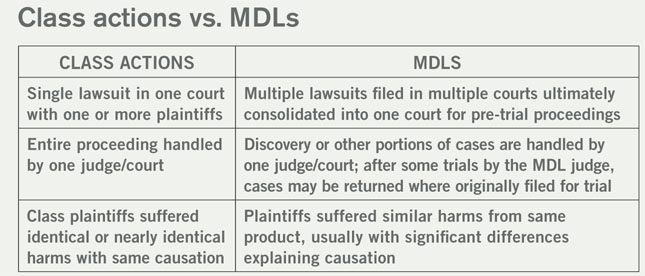
CHEAT SHEET
- Danger in numbers. Class actions and multidistrict litigation (MDL) have seen a consistent increase in the last decade. Both types of lawsuits can last for years and cost the company valuable time and money.
- Reduce risk. When communicating the risks of large-scale litigation to your business colleagues, discuss how to avoid social media or document mishaps, the need to remain candid and professional in business communications, and when to engage counsel.
- Rule 23. US Federal Rule of Civil Procedure 23 provides an opportunity for early success from a class action if its requirements and thresholds, like typicality and adequacy, are the focus of your strategy from the beginning.
- Case evaluation. Developing a process to verify product use and closely examining statutes of limitations and repose during an MDL case evaluation can expose threshold issues and significantly reduce the volume of cases.
Today, more than ever, companies face a tangled morass of legal challenges. Litigation is on the rise and attorneys’ fees are through the roof. In this global economy, a company’s potential for exposure can be massive. Only a cursory glance at headlines confirms the point: BP paid more than US$20 billion to settle claims related to the Deep Water Horizon disaster, while Bayer floated a settlement proposal valued at nearly US$8 billion to resolve lawsuits surrounding its on-going Roundup weed killer litigation.
Among the most significant threats that generate high levels of company exposure and reputational risk are class actions and multidistrict litigation (MDL). While it is impossible for a target company to totally eliminate the risk of these kinds of proceedings, developing a better understanding of each will inform a cogent strategy for the earliest possible resolution. And educating business clients so they can avoid compounding the risks is all the more important. This article touches on the similarities and differences presented by class actions and MDLs and offers a few pointers to tame those respective nightmares.

Critical differences between class actions and MDLs
Class actions defined
A class action case involves a single lawsuit filed by a group of plaintiffs who have allegedly suffered similar harms at the hands of the same defendant or defendants. This proposed “class” must demonstrate that the associated individuals or businesses have sustained a common injury from the defendant’s common conduct, as class actions are only appropriate where the injuries and conduct toward the class members are the same or very similar. As a result of similar injuries arising from common conduct, and the affected individuals or businesses consolidating into a class, there is only one lawsuit that addresses the entire litigation. At the end of the day, if the class becomes certified, and proves the defendant’s liability and injury, damages are divided among class members.
MDLs defined
MDLs involve multiple lawsuits (hence multidistrict litigation) filed by plaintiffs in different courts against the same defendant or defendants. Those various plaintiffs typically claim injuries caused by the same product or conduct. The various causes and extent of alleged injuries for certain cases, however, preclude such cases from being adjudicated jointly.
So instead of consolidating the multiple plaintiffs into one similarly situated case for purposes of global resolution, MDLs join multiple plaintiffs and lawsuits into one court for pre-trial proceedings and judicial efficiency. Many pre-trial proceedings (including and especially discovery) can be completed in one fell swoop, particularly when certain liability issues (such as how and why a product caused injury) may be the same across multiple cases.
An MDL court usually conducts a few trials aimed to provide strategic guidance to both sides on trial outcome predictability. If the MDL court does not dismiss the entire number of cases (for various reasons), cases may be sent back to their original courts for trial.
Reasons for class action and MDL confusion
Class action suits and MDLs are hairy litigations that present some of the same issues. Both involve large groups of claimants — sometimes numbering in the thousands — as opposed to typical cases with a single plaintiff or a small group. Of course, the definition of a “typical” civil case is changing: In 2018, MDL cases comprised a whopping 52 percent of the federal docket. As demonstrated below, the rise of MDL cases has been a consistent trend over the past decade.
Class actions have seen a similar spike. For example, the number of securities class actions filed in federal court doubled from 2014 to 2019.
Class actions and MDLs are also both extremely costly, complicated, time-consuming, and downright hazardous to a company’s bottom line. These are the situations that bring on the white hairs, and they can both last for years. Class actions may extend to allegations from hundreds of thousands of class members (recall the recent Volkswagen emissions scandal culminating in a multi-billion-dollar class settlement). Of similar scope, an MDL can include many thousands of individual cases (the Johnson & Johnson talcum powder MDL includes nearly 15,000).
While those litigations both presented significant exposure, the Volkswagen class action and Johnson & Johnson MDL illustrate the primary difference between these types of proceedings. With the Volkswagen case, the auto manufacturer installed the exact same software on millions of automobiles to evade EPA emissions testing, and consumers who purchased affected autos suffered identical harms (paying increased prices for faulty vehicles). Meanwhile, although the Johnson & Johnson talcum powder MDL involved various cases that alleged the same product caused injury, the alleged harm varied widely, with individuals affected by various ailments with largely different impacts.
Despite their differences, given the stakes in either a class action or an MDL, an uninformed legal decision will hurt. Accordingly, educating business clients in helping to avoid these risks altogether should be a focus of any in-house lawyer. Among other tips, teach business employees about the risks associated with large-scale litigation; when and how to properly engage counsel in internal discussions; how to avoid creating bad documents or social media missteps; the importance of raising problems for resolution as soon as they arise; and the need to always remain candid and professional (particularly over e-mail).

Class actions
Class actions are fraught with risk given the massive financial exposure riding on a single case. But defendant companies have some levers to pull that provide sincere opportunities for success.
One of the foremost challenges facing plaintiffs in class actions are the various requirements imposed for class certification by Federal Rule of Civil Procedure 23 (most states have adopted a corollary to Rule 23 that applies with similar force in state court litigation). Those requirements provide an opportunity to end a class action and eliminate organizational risk with an early escape, short of a massive settlement or victory on a motion to dismiss.
Four factors to be satisfied
There are four Rule 23(a) factors that must be satisfied for all class action cases:
- Numerosity. Often a class is sufficiently numerous if it has more than 40 members.
- Commonality. Common questions must exist, and those questions must find resolution in common answers.
- Typicality. The claims of the class representatives must be typical of claims of the class.
- Adequacy of class: representative and counsel.
- The class representatives must have no major conflicts of interest with absent class members.
- Counsel must have the requisite experience with the claims and class actions and must avoid significant errors over the course of the case.
PRACTICE TIP
For greater likelihood of early success, focus on the requirements of Rule 23 from the inception of a class action case, and tailor your company’s early strategy around defeating those threshold issues (particularly typicality and adequacy, which are often ripe for defeat).
One of three additional factors to be satisfied
Satisfying the four class-similarity requirements, however, is not enough. A class action is only appropriate when one of the three issues outlined under Rule 23(b) is also present.
Actions at risk of inconsistent rulings
Rule 23(b)(1)(A) and (B): Although extremely unusual, a class can be certified if there is a risk of inconsistent rulings that would create differing standards of conduct for the party opposing a class, or where available funds are less than total damages (one such example involved the Supreme Court’s decision in Ortiz v. Fibreboard Corp., 527 U.S. 815 (1999), which involved harms caused by asbestos).
Actions seeking declaratory or injunctive relief
Rule 23(b)(2): This subsection covers classes seeking declaratory or injunctive relief where the opposing party has “acted or refused to act” on grounds that apply to the entire class. These cases often involve actions seeking to vindicate civil rights of a group of similarly situated plaintiffs.
Actions seeking monetary damages — predominance and superiority
Rule 23(b)(3): For cases in which the class seeks damages, the named plaintiffs must establish predominance and superiority.
- For predominance, common issues must predominate over individual issues. Claims such as fraud, which require individual reliance, and other cases with unique defenses, are particularly problematic for predominance.
- For superiority, the proponent of class certification must demonstrate it is the best way to litigate the case.
Defeating certification of the related class — by, for example, demonstrating that the various injuries suffered by a class do not involve significant factual overlap and therefore fail for want of commonality and typicality — is usually the death of class action cases. A single plaintiff simply does not offer the financial benefit for a feasible lawsuit. But this is a double-edged sword; certification of a class empowers class counsel and representatives to negotiate with a cudgel.
Practice Tip
Ask each named plaintiff how he or she first learned and became involved in the lawsuit. If the circumstances fit the think-tank conception model described here, use that information in every filing with the court and every chance you get before a jury.
Another potential factor that tilts in favor of defendants to class actions arises from the fact that many class-action cases involve, shall we say, creative theories of liability developed by imaginative plaintiff firms. These firms are studied in the methods of identifying potential class action claims, and once conceived, the firms run television, radio, print, and/or online advertising to seek potential plaintiffs to fill and then expand the class (before and even after filing a case). When this is true of all named plaintiffs — a very real possibility for hard-charging class action firms — a compelling defense materializes.
MDLs
Although MDLs sound complicated, MDLs provide their own strategic advantages that can be utilized by a corporate defendant.
Advantages of MDLs
- Judicial and economic efficiency. MDLs offer significant judicial and economic efficiency (at least when compared to the alternative). Instead of tens, hundreds, or even thousands of cases pending in different courts across the country, MDLs are coordinated into a single forum and address legal issues germane to most, if not all, cases. This saves companies significant time, attorneys’ fees, and costs. If the MDL court has a legal basis justifying dismissal of all cases, such as a favorable ruling on causation, judicial economy served its purpose.
- Reduced disruption to key employees. MDLs generally reduce the disruption to a defendant company’s business, particularly as it relates to taking key individuals away from their roles in the company. Without an MDL, those employees could face multiple, serial depositions that preclude them from completing their day-to-day work. Corporate defendants could spend massive hours responding to similar deposition and discovery requests across a large number of cases. An MDL streamlines the process so that discovery across all cases is coordinated. Key company witnesses present for deposition once, the record is used in all related cases, and a defendant’s responses apply across all relevant discovery requests in all pending cases.
- Increased consistency. MDLs provide much-needed consistency across the various cases. Instead of having dozens (again, even hundreds or thousands) of different judges rendering decisions about discovery, depositions, summary judgment, etc., a single judge becomes an expert in both the facts and relevant law and renders rulings. Instead of potentially winning and losing the same battles in different courts (inconsistency that would exponentially expand a defendant’s risk), the MDL provides singular decisions at important turning points.
- These advantages streamline what would otherwise be highly disruptive litigation, allowing corporate defendants to focus more on their core business and minimize the distraction of litigation.
- Some weak claims. Data suggests that approximately one-third of all filed MDL cases result in findings of unsupportable allegations, largely because claimants did not use the product involved, had not suffered the adverse consequence in suit, or because the statute of limitations expired before the claimant filed suit. Such weaknesses can be identified and attacked.
Practice Tip
Early case evaluation, such as closely examining the applicable statutes of limitation and repose for each case, and developing a process to identify actual product use, may reveal threshold issues that will significantly reduce the volume of cases in an MDL, preventing it from running amok.
Disadvantages of MDLs
- Lengthy proceedings and high volume equals increased reputational risk. MDLs may drag on longer than class actions, in some cases lasting five years or more, and the long slog can wear down even the most resilient businesses. MDLs attract heightened publicity, so pending MDLs may attract additional lawsuits even after the various cases have been filed and consolidated (an MDL can always take on more related lawsuits). Plaintiffs often assume a high volume of cases means a corporation must be at fault, so more plaintiffs will sue without credibly pre-vetting their claims.
- Plaintiffs work together. The combination of claims in a single forum will acquaint the various plaintiffs’ counsel and permit the pooling of resources to work for the “common benefit.” MDLs also provide plaintiffs with a related organizational advantage, as it would be difficult and time-consuming to coordinate dozens or hundreds of firms to discern litigation tactics.
- No single path to victory. It is also far more difficult for a defendant to win an MDL outright as compared to a class action. There is no threshold class certification standard that the plaintiffs must meet. Defendants cannot defeat the entire MDL at just one trial, as they could in a class action, but must address each plaintiff individually (assuming the MDL court does not dismiss the entire MDL). Even the most favorable legal rulings may not wipe out all of the plaintiffs’ claims or all of the multiple lawsuits. For those reasons, numerous MDLs resolve in global settlements.
Practice Tip
Although MDLs allow cases to come together for the big issues involving discovery and even liability, defendants can attack each individual case, and related damages, once returned to the home jurisdiction for ultimate resolution.
Parting practice considerations
So, there you have it. MDLs and class actions are on the rise, and every company — and its lawyers — should be familiar with the ins and outs prior to being sucked into one of these monstrosities. If your company is as successful as you hope, you are at risk of being on the wrong end of a class action or MDL.
But remember, there are advantages you can exploit in both MDLs and class actions. For class actions, attack class certification under Rule 23 early and often; work to distinguish the causation facts for the different plaintiffs; and work to establish rapport with opposing counsel in the hopes of early and inexpensive resolution. In MDLs, expect and attack weak cases; enjoy the lesser disruption to key employees; and seek legal rulings that may knock out large numbers of cases (or even the whole thing).
In either case, focus on the efficiencies, and — whenever possible — hire experienced outside counsel to light the way.
For more information on MDLs, read the authors’ companion article 7 Strategies to a Multidistrict Litigation Victory.
References
See, e.g., Minn. R. Civ. P. 23.
See Fed. R. Civ. P. 23 advisory committee’s note (1966) (“Illustrative [of Rule 23(b)(2) class actions] are various actions in the civil-rights field where a party is charged with discriminating unlawfully against a class, usually one whose members are incapable of specific enumeration”).
Advisory Committee Rules of Civil Procedure, MDL Subcommittee Report, Nov. 1, 2018, at 142, available at www.uscourts.gov/sites/default/files/2018-11_civil_rules_agenda_book_0.pdf.
ACC EXTRAS ON… Class actions
ACC Docket
The First Step to Take When Hit with a New Class Action (Oct. 2018).
Articles
The International Comparative Legal Guide to Class & Group Actions 2019, 11th Edition (Nov. 2018).
Sample Forms, Policies, and Contracts
National Class Actions – Defense and Settlement (April 2018).





